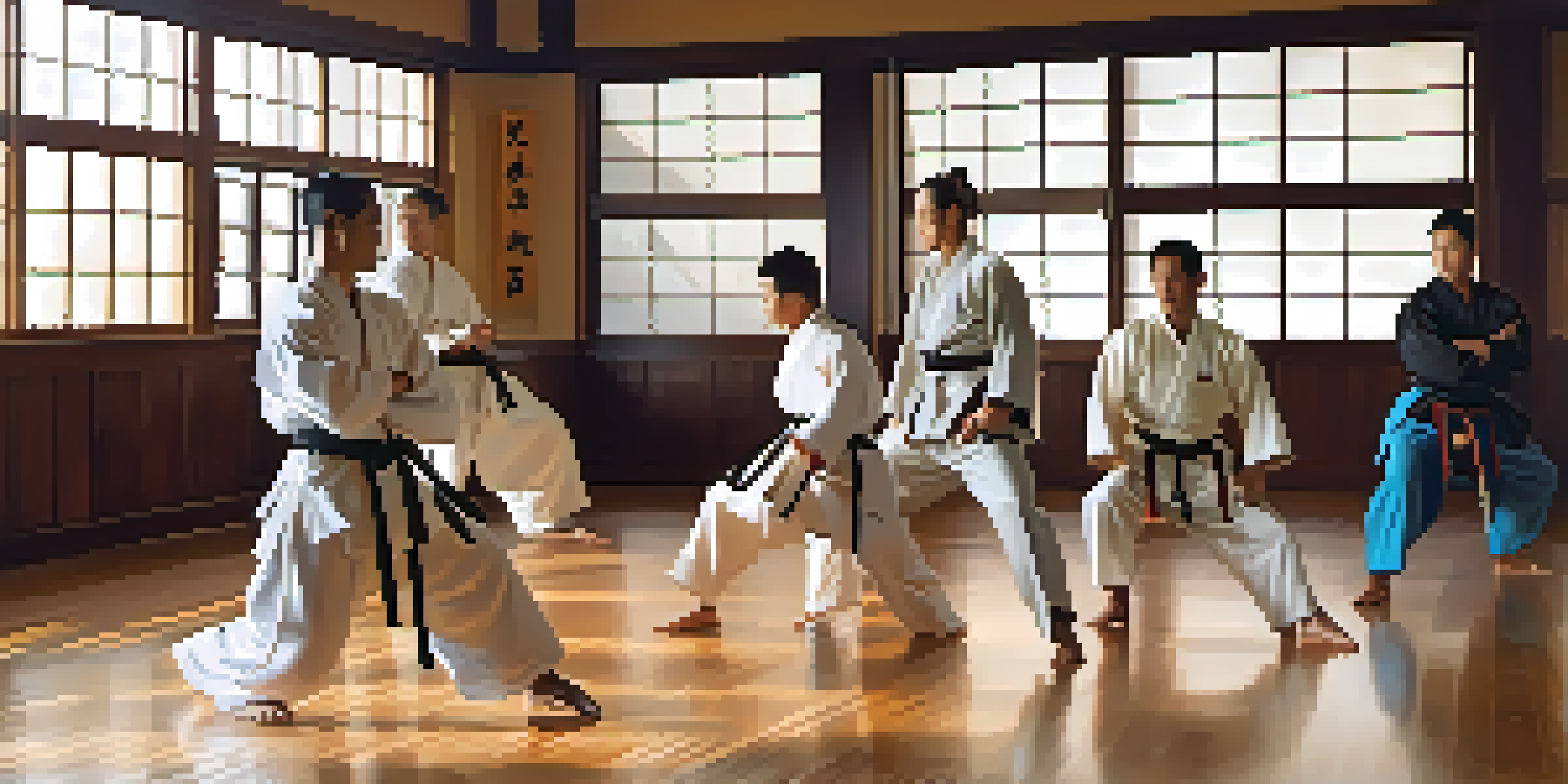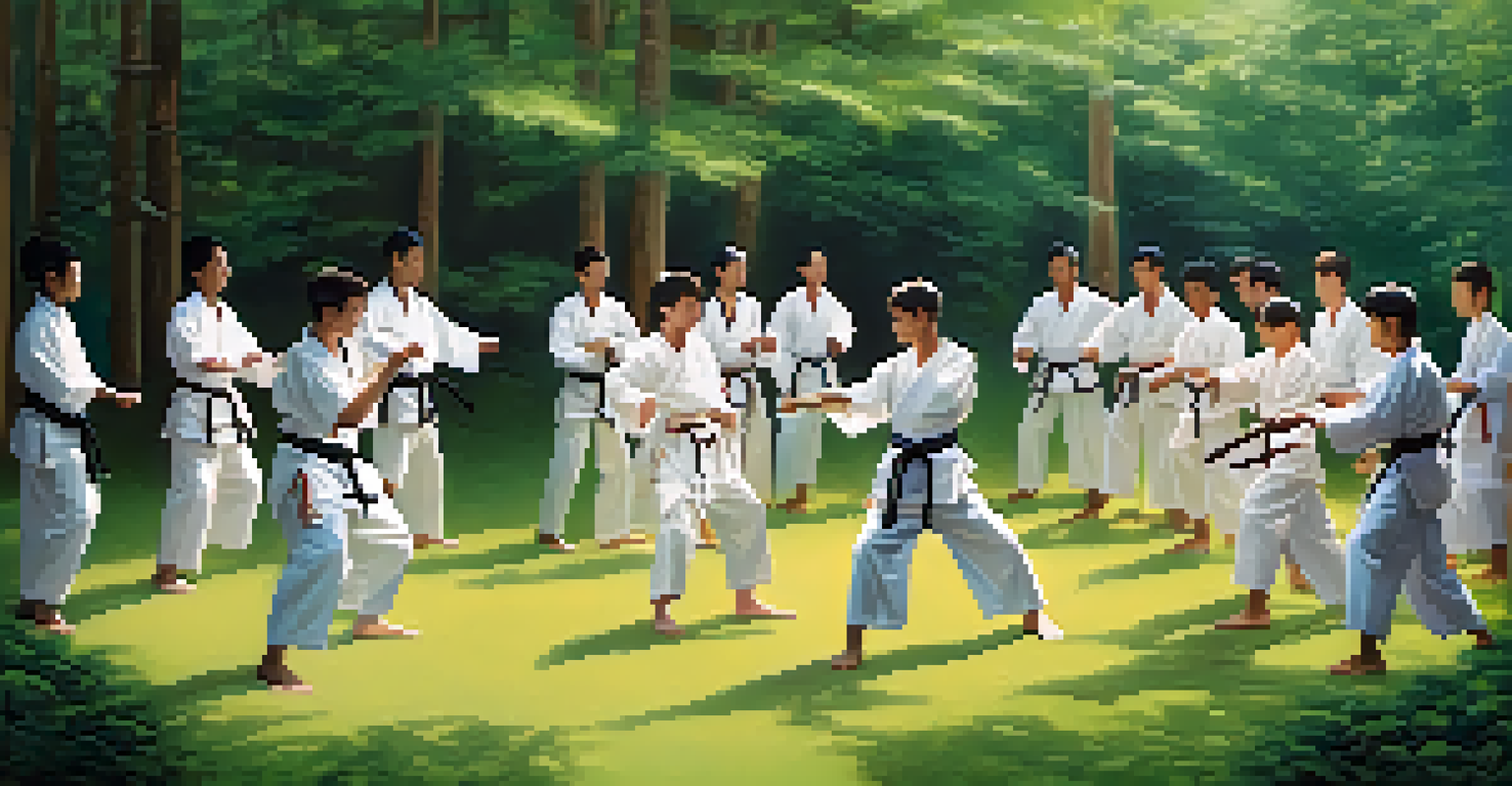Cultural Exchange Through Martial Arts in Global Relations

Understanding Martial Arts as a Cultural Bridge
Martial arts are not just forms of self-defense; they embody rich cultural traditions. Each style offers a glimpse into the values and philosophies of its origin, such as discipline in karate or adaptability in Brazilian jiu-jitsu. This cultural depth makes martial arts a unique vehicle for exchange, allowing practitioners to connect over shared interests while respecting differences.
Martial arts is not about the movement; it's about the mindset.
As practitioners travel to learn and share techniques, they create bonds that extend beyond the dojo. For instance, a student from the U.S. may train in a dojo in Japan, absorbing not just the physical techniques but also the local customs and etiquette. This immersion fosters mutual respect and understanding, key components for building strong global relationships.
Moreover, martial arts can serve as a common language among diverse cultures. When practitioners engage in training sessions, competitions, or exhibitions, they communicate through movements rather than words, breaking down barriers and facilitating connections that may otherwise remain elusive.
The Role of International Competitions in Cultural Exchange
International martial arts competitions, like the World Taekwondo Championships, showcase not only athletic prowess but also cultural diversity. Athletes from various countries come together, bringing their unique traditions and backgrounds to the mat. These events become melting pots of ideas, fostering camaraderie and respect among participants.

During these competitions, countries often share their distinct styles, techniques, and philosophies. For instance, a karateka from Japan might demonstrate a kata, while a capoeirista from Brazil showcases their rhythmic movements. Such exchanges highlight the beauty of diversity and promote understanding among different martial arts communities.
Martial Arts as Cultural Connectors
Martial arts serve as a cultural bridge, allowing practitioners to connect over shared interests while respecting diverse traditions.
Additionally, these events often involve cultural exhibitions or workshops, allowing spectators and participants to engage with one another beyond competition. This creates lasting friendships and networks, proving that martial arts can serve as a bridge for ongoing dialogue and collaboration among nations.
Martial Arts as a Tool for Peacebuilding
Martial arts have a long-standing history of being used as tools for peacebuilding in conflict regions. Programs that teach martial arts to youth often focus on discipline, respect, and conflict resolution, instilling values that promote peace. In areas affected by violence, these programs can provide a constructive outlet for energy and emotions, steering individuals away from conflict.
The more I learn about different martial arts, the more I realize how similar we all are.
For example, in cities grappling with gang violence, martial arts clubs have emerged as safe havens. Young people learn self-defense while also developing skills in teamwork and perseverance. These clubs not only improve physical health but also foster a sense of community, helping to reduce tensions and promote understanding among diverse groups.
Moreover, global initiatives like the Peace Corps have incorporated martial arts training into their programs, using it as a means to unite communities. By facilitating shared experiences through martial arts, these initiatives contribute to fostering harmony and cooperation, illustrating the profound role martial arts can play in global relations.
Cultural Sensitivity in Martial Arts Training
While engaging in martial arts, cultural sensitivity is paramount. It's essential for practitioners to understand and respect the traditions and customs associated with different styles. This respect not only enriches the training experience but also honors the heritage of the martial art being practiced.
For instance, bowing before entering a dojo or understanding the significance of rituals in training sessions reflects a deep appreciation for the culture. Such practices emphasize the importance of humility and respect, values that are central to many martial arts traditions. Practitioners who embrace these nuances are more likely to foster genuine relationships with their peers from different backgrounds.
Global Competitions Foster Unity
International martial arts competitions promote cultural exchange and understanding among participants from various backgrounds.
Additionally, instructors play a vital role in teaching cultural sensitivity. By integrating lessons about the historical context and cultural significance of techniques, they prepare students to engage respectfully with diverse martial arts communities. This approach not only enhances individual practice but also contributes to a more harmonious global martial arts landscape.
Martial Arts in a Globalized World
In today's interconnected world, martial arts continue to evolve and adapt. Globalization has facilitated the spread of various martial arts, allowing people from different backgrounds to cross-train and share their experiences. This sharing of knowledge enriches each style and fosters a sense of unity among practitioners across the globe.
As martial arts schools pop up in cities worldwide, they often blend techniques and philosophies, creating hybrid styles. For instance, mixed martial arts (MMA) combines elements from various disciplines, reflecting the global nature of modern training. This cross-pollination not only enhances individual skills but also promotes an inclusive atmosphere where diverse traditions can coexist and thrive.
However, with this globalization comes the responsibility to maintain the integrity of the original styles. Practitioners must navigate the balance between innovation and tradition, ensuring that the cultural significance of their martial arts is preserved. By doing so, they contribute to a richer, more diverse global martial arts community.
The Impact of Martial Arts Media on Cultural Exchange
Martial arts films and television shows have played a significant role in popularizing various styles and cultures worldwide. Movies like 'Crouching Tiger, Hidden Dragon' and 'The Karate Kid' have introduced audiences to the philosophies and techniques of martial arts, sparking interest and participation. These portrayals can inspire individuals to pursue training and learn about different cultures.
Social media platforms also amplify this cultural exchange, connecting practitioners and enthusiasts from around the world. Videos showcasing unique techniques, cultural practices, and competitions can go viral, reaching audiences far beyond geographical boundaries. This digital sharing fosters a global community where ideas, techniques, and experiences are exchanged freely.
Friendships Beyond Borders
Practicing martial arts creates lifelong friendships that transcend cultural and geographical barriers, fostering a global community.
However, it's crucial to approach these media representations critically. Often, they can oversimplify or misrepresent the rich cultural heritage of martial arts. By promoting accurate portrayals and encouraging dialogue, martial arts media can serve as a powerful tool for fostering understanding and appreciation among diverse cultures.
Building Lifelong Friendships Through Martial Arts
One of the most rewarding aspects of practicing martial arts is the friendships that develop along the way. As practitioners train together, they share challenges, victories, and moments of growth, creating strong bonds that often last a lifetime. These friendships transcend borders and cultures, uniting individuals through their passion for martial arts.
Participating in seminars, competitions, and training camps provides opportunities to meet fellow enthusiasts from around the globe. These experiences enable practitioners to exchange techniques and cultural insights, further enriching their training. As they immerse themselves in different environments, they learn to appreciate the beauty of diversity while finding common ground.

Ultimately, these friendships contribute to a broader understanding of the world. Practitioners become ambassadors of their culture, sharing their experiences and learning from others. Through martial arts, they build a network of support and understanding that extends far beyond the dojo, fostering a global community united by respect and appreciation for each other's backgrounds.